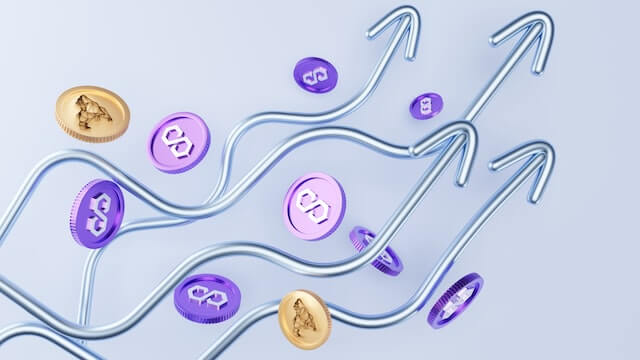Polygon (MATIC)
Bringing the World to EthereumThe native cryptocurrency of Polygon, MATIC is now one of the world’s most popular tokens. Its importance looks set to grow as the Polygon ecosystem grows stronger. Here we’ll tell you everything you need to know about Polygon and how you can use MATIC.

What is Polygon (MATIC)?
Formerly known as the ‘MATIC Network’, Polygon was founded in 2017 by Indian software engineers Jaynti Kanani, Sandeep Nailwal, Anurag Arjun, and Mihailo Bjelic in Mumbai. It was conceived as a decentralised scaling platform for Ethereum – aiming to address the network’s notoriously high processing fees and congestion. The platform’s native token is called MATIC.
Because Polygon runs on Ethereum, it serves to connect many different projects, giving users a host of extra features. Notably, Polygon can serve as a bridge for communication between Ethereum and other blockchains.
| Did you know? Mark Cuban, billionaire owner of the Dallas Mavericks NBA team is one of the investors in Polygon. Source: CoinMe |

Polygon Basics
Polygon combines the best elements of the Ethereum blockchain with many independent blockchains. This enables it to offload congestion from the Ethereum network, while retaining its positive network effects.
Polygon Blockchain
Instead of a standard proof-of-stake consensus mechanism, Polygon employs zero-knowledge rollups (sk rollups)., which enables data to be validated more quickly. There are many parts to the overall Polygon ecosystem, but these are the current main ones:
- Polygon PoS is a EVM-compatible Ethereum sidechain.
- Polygon Edge is a modular framework for creating private or public Ethereum-compatible blockchains.
- Polygon Supernets are a complete service to build and power dedicated blockchains.
MATIC Issuance and Staking
New MATIC tokens are minted by Polygon network stakers in return for validating transactions. Validators are chosen by random on the Polygon network.
MATIC Supply
The supply of MATIC is limited to 10 billion. According to Coindesk, as of late 2021, around 7.16 billion were in circulation.
Polygon Adoption & Usability
In early 2021, MATIC Network rebranded as Polygon and to position itself as a metaverse solution. This sparked a significant acceleration in growth, and in December the project acquired another startup, Predicate Labs – developer of the Mir blockchain.
In early 2022, Polygon raised an impressive $450M via a MATIC token sale to investors, and in April major financial solutions company Stripe selected Polygon for its crypto payments. In summer 2022, Polygon joined Disney’s augmented reality, NFT and AI focused Acceleration Program.
According to CoinGecko, by late October 2022, MATIC was the world’s 12th biggest cryptocurrency by market capitalization, at just under US$5.6B. In addition to being the network token of Polygon, MATIC is also accepted as a payment option at an increasing number of online retailers and service providers.
Polygon Fees & Speed
Polygon was specifically designed to address the major problems faced by Ethereum – which chiefly revolved around network congestion and high transaction fees. In this it has succeeded, with typical transaction fees on Polygon as low as 1 cent, while the network can process up to 65,000 transactions per second.
| Did you know? Coca-Cola, the world’s most recognisable soft drinks company, released a limited edition NFT collection on Polygon in 2022 as part of its exploration into Web3. Source: The Motley Fool |
Polygon Security and Safety
The Polygon network has proven itself to be robust and safe. By allowing smaller blockchain projects to still harness the network effects of Ethereum, it gives big network security to relatively small projects. But, like all cryptocurrencies, MATIC has been lost through hacks and scams. As always, third-party sites like crypto exchanges are particularly vulnerable points.
Security and safety tips:
- Don’t leave your MATIC on exchanges. Use exchanges for buying and selling only. Always transfer your crypto to a local wallet for short-term storage.
- For long-term storage, keep your crypto in a hard wallet.
- Always keep your wallet keys in multiple safe places – they cannot be recovered.
- Never tell anyone about your crypto holdings. No matter how secure your storage is, if you or your loved ones are physically threatened, you’ll probably hand over your personal keys.
MATIC Volatility
As with all cryptocurrencies, except stablecoins, MATIC has seen significant price volatility since launching. According to CoinGecko data, at the time in October 2022, MATIC’s price stood at around $0.90, down from an all-time high of $2.92, which it achieved on 27 December 2021. Conversely, its all-time low was $0.003, on 10 May 2019.
Final Word on Polygon (MATIC)
As a scaling solution, Polygon clearly has an incredible amount of potential. It looks set to be adopted by more and more projects looking to tap the network effects of Ethereum while avoiding the high fees and congestion – something that is likely to plague Ethereum at least until all of the Ethereum 2.0 upgrades have been implemented, which could take years.
As a cryptocurrency in its own right, MATIC has several attributes that make it ideally suited to a multitude of transactions – namely it is fast, low cost, and secure. It has certainly overcome the major issues associated with Ethereum, which is what it was designed to do. However, like many other great altcoins, it simply isn’t as widely accepted right now. Will this change in the future? Probably, and then Polygon will be a top choice for many.
